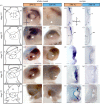Krüppel-like factor/specificity protein evolution in the Spiralia and the implications for cephalopod visual system novelties
- PMID: 33081641
- PMCID: PMC7661307
- DOI: 10.1098/rspb.2020.2055
Krüppel-like factor/specificity protein evolution in the Spiralia and the implications for cephalopod visual system novelties
Abstract
The cephalopod visual system is an exquisite example of convergence in biological complexity. However, we have little understanding of the genetic and molecular mechanisms underpinning its elaboration. The generation of new genetic material is considered a significant contributor to the evolution of biological novelty. We sought to understand if this mechanism may be contributing to cephalopod-specific visual system novelties. Specifically, we identified duplications in the Krüppel-like factor/specificity protein (KLF/SP) sub-family of C2H2 zinc-finger transcription factors in the squid Doryteuthis pealeii. We cloned and analysed gene expression of the KLF/SP family, including two paralogs of the DpSP6-9 gene. These duplicates showed overlapping expression domains but one paralog showed unique expression in the developing squid lens, suggesting a neofunctionalization of DpSP6-9a. To better understand this neofunctionalization, we performed a thorough phylogenetic analysis of SP6-9 orthologues in the Spiralia. We find multiple duplications and losses of the SP6-9 gene throughout spiralian lineages and at least one cephalopod-specific duplication. This work supports the hypothesis that gene duplication and neofunctionalization contribute to novel traits like the cephalopod image-forming eye and to the diversity found within Spiralia.
Keywords: Spiralia; cephalopod; eye evolution; lens; neofunctionalization; transcription factor.
Conflict of interest statement
We declare we have no competing interests.
Figures





Similar articles
-
Co-option of the limb patterning program in cephalopod eye development.BMC Biol. 2022 Jan 5;20(1):1. doi: 10.1186/s12915-021-01182-2. BMC Biol. 2022. PMID: 34983491 Free PMC article.
-
Genomic signatures of G-protein-coupled receptor expansions reveal functional transitions in the evolution of cephalopod signal transduction.Proc Biol Sci. 2019 Feb 27;286(1897):20182929. doi: 10.1098/rspb.2018.2929. Proc Biol Sci. 2019. PMID: 30963849 Free PMC article.
-
Eye development and photoreceptor differentiation in the cephalopod Doryteuthis pealeii.Development. 2016 Sep 1;143(17):3168-81. doi: 10.1242/dev.134254. Epub 2016 Aug 10. Development. 2016. PMID: 27510978
-
Evolution of the CT/CGRP family: comparative study with new data from models of teleosts, the eel, and cephalopod molluscs, the cuttlefish and the nautilus.Gen Comp Endocrinol. 2007 Aug-Sep;153(1-3):155-69. doi: 10.1016/j.ygcen.2007.01.027. Epub 2007 Jan 30. Gen Comp Endocrinol. 2007. PMID: 17353015 Review.
-
Cephalopod Biology: At the Intersection Between Genomic and Organismal Novelties.Annu Rev Anim Biosci. 2020 Feb 15;8:71-90. doi: 10.1146/annurev-animal-021419-083609. Epub 2019 Dec 9. Annu Rev Anim Biosci. 2020. PMID: 31815522 Review.
Cited by
-
Co-option of the limb patterning program in cephalopod eye development.BMC Biol. 2022 Jan 5;20(1):1. doi: 10.1186/s12915-021-01182-2. BMC Biol. 2022. PMID: 34983491 Free PMC article.
-
A single-cell atlas of the bobtail squid visual and nervous system highlights molecular principles of convergent evolution.Nat Ecol Evol. 2025 Jul;9(7):1245-1262. doi: 10.1038/s41559-025-02720-9. Epub 2025 Jun 6. Nat Ecol Evol. 2025. PMID: 40481147 Free PMC article.
-
Genome and transcriptome analysis of the beet armyworm Spodoptera exigua reveals targets for pest control.G3 (Bethesda). 2021 Oct 19;11(11):jkab311. doi: 10.1093/g3journal/jkab311. G3 (Bethesda). 2021. PMID: 34557910 Free PMC article.
References
-
- Ohno S. 1970. Evolution by gene duplication. Berlin, Germany: Springer.
Publication types
MeSH terms
Substances
Associated data
Grants and funding
LinkOut - more resources
Full Text Sources

